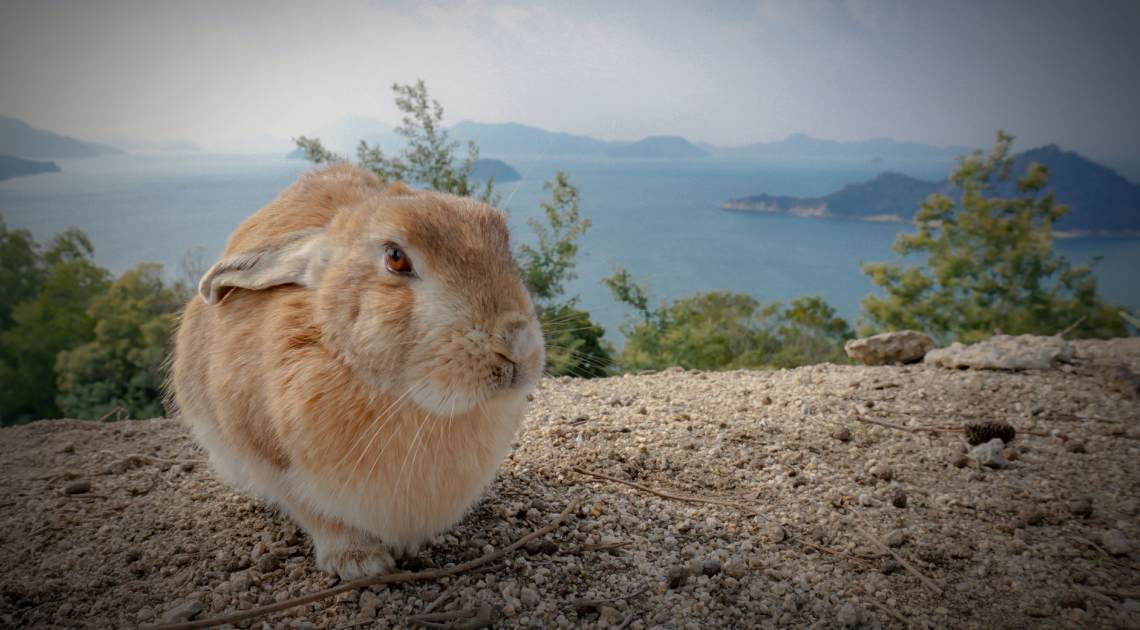Around the world are countless animal sanctuaries where species can live in harmony. Off the coast of Japan exists a unique sanctuary: an island full of rabbits! The simply named Rabbit Island might seem like a cuddlesome paradise, but the island’s past and present have dark secrets that threaten the existence of its cute inhabitants.
Where is Rabbit Island?
Rabbit Island is located on the small island Ōkunoshima in the Seto Inland Sea in eastern Hiroshima. Instead of Ōkunoshima, the island is often called Usagi Shima (Rabbit Island in English). The island is home to over 1,000 wild rabbits, who have plenty of fields and forests to explore.
Dark and Historical Origins
But how do that many rabbits end up in one place? There are many rumors about how these cuddly creatures arrived, some more morbid than others.
The first rumor ties back to WWII when Ōkunoshima was previously used as a chemical munitions plant to manufacture tear and mustard gas. Despite the Geneva Protocol banning the use of chemical weapons in 1925, a loophole existed where these vile weapons could still be created and stored away. The rabbits were unfortunate test subjects for these experiments, brought to the island to determine the effectiveness of the weapons. The remaining rabbits got released by the workers following WWII’s end, left to survive in the wild.

Chemical storage area, Okunoshima, Japan. Via Wikimedia Commons.
However, Ellis Krauss, a Japanese politics professor at the University of California San Diego, disputed this rumor. In an interview with Krauss, he revealed that the Americans who liberated the island euthanized all the rabbits used for experiments.
So if those rabbits were gone, how did all of those bunnies end up on the island? Another rumor points to the antics of school children, who set free eight rabbits onto the island during a field trip. With no predators or hunters to disrupt them, the rabbits multiplied into the large population the island is known for today.
Can I Visit the Rabbits?
Not only can you visit the rabbits, but you can also make an entire vacation out of it! Visitors can either take a boat in from the mainland for a day visit or stay at the National Park Resort Hotel, a vacation spot on the island. Visitors can interact with rabbits, bike around the island, sit in simmering hot springs, and even visit the chemical plants used during WWII, now converted into the Ōkunoshima Poison Gas Museum. It sounds like the perfect location for any couple’s bunnymoon.
Rabbit Island in Japan 🐰 pic.twitter.com/l8mh4tG39G
— follow me if you love japan ➐ (@japaxnn) October 10, 2021
The island has strict guidelines for the safety of its furry folk. Rabbit Island forbids tourists from chasing, holding, or taking a wild rabbit home. Tourists also cannot release their pet rabbits on the island, as the local rabbits are territorial and will not accept an outsider as one of their own. Rabbit Island also requests that guests refill water buckets around the island (more on that soon) and watch out for rabbits while biking or driving.
The Rabbits’ Dark Secret
At a glance, Rabbit Island seems like a paradise with a dark and historic past, but it also has a very present threat: the tourists themselves.
Due to the island not having enough vegetation to support its large population, rabbits rely on the tourists to feed them, resulting in inconsistent feeding times and bad diets. Rabbits are overfed on crowded tourism days and barely eat on bad weather days with little foot traffic.
Typically, a wild rabbit’s diet consists of leaves, plants, and seeds. However, tourists often bring carrots and cabbage to feed their new long-eared friends. Cabbage is deficient for rabbits since they have difficulty digesting it, and the food is too low in fiber for their dietary needs.
Food isn’t the only issue for the rabbits. Due to toxins from Japan’s experiments during WWII, the island’s groundwater got contaminated. This is why the island asks tourists to refill water buckets for the rabbits. All these factors culminate in a high turnover rate for the rabbits, only having a two-year lifespan.
Luck Be a Rabbit
Despite the dark secrets of Rabbit Island, the animals are very significant to Japan. In Japanese culture, rabbits symbolize luck, whereas the Japanese kanji for rabbit is similar to the kanji meaning “get rid of” or “vanish.” Hence, rabbits will make your bad luck go away!
Rabbits are also associated with fertility and rebirth due to their high reproductive rates. Rabbit Island supports this notion by encouraging those trying to start a family to visit the island to receive good fortune from its prosperous whiskered winners.
If you find yourself hoping over to Rabbit Island, remember to reflect on its hairy past and take steps to create a positive environment for the island’s rabbits and all of rabbit kind.
By James Whelan, contributor for Ripleys.com










Comment Your Reaction